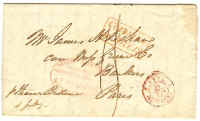|
Retail Sales |
|
|
|
|
Click on thumbnail for large image |
|
|
Spotlight On Harnden's Foreign Letter Express
William Harnden is considered to be the "father" of the express business in the United States. His first advertisement appeared on February 23, 1839 and announced express car service four times a week between Boston and New York. The primary function was the handling of small packages, money, and orders for goods. In November, 1840 Dexter Brigham Jr. set up an office in Liverpool to establish a trans-Atlantic express and foreign exchange business. This business thrived when Harndens became the exclusive agent for light freight shipped to England by the Cunard Line steamers.
Prior to 1848, prepaid mails to foreign destinations was possible only by using agents such as Harnden. For example, a letter prepaid to Harnden in Boston could be sent by steamer to the Liverpool office and mailed by the Harnden agent there, using the British postal system, to any destination linked from England.
This presentation will show the mail handling aspects of Harndens Foreign Letter Office. Harndens operated simultaneously as a contract mail carrier and as a private express during two separate time periods. This enabled him to have a virtual monopoly on legal mail destined to be carried on Cunard Line steamers before the treaty mails were instituted in 1848. It was an unusual circumstance for a private express company to also have a mail carrying contract. For the "collection" pages linked, the following color coding is used:
black - United States or foreign post
office mail
gray - hybrid
of private mail and contract mail with Harnden acting as mail carrying
contractor
red - Harnden operating as a private
express
blue - other private conveyance
The intact, mounted collection, one frame, is available for sale. It includes usages to Finland, Bremen, Holland, Calcutta, Hamburg, Azores, Switzerland, and Prussia. Price upon request.
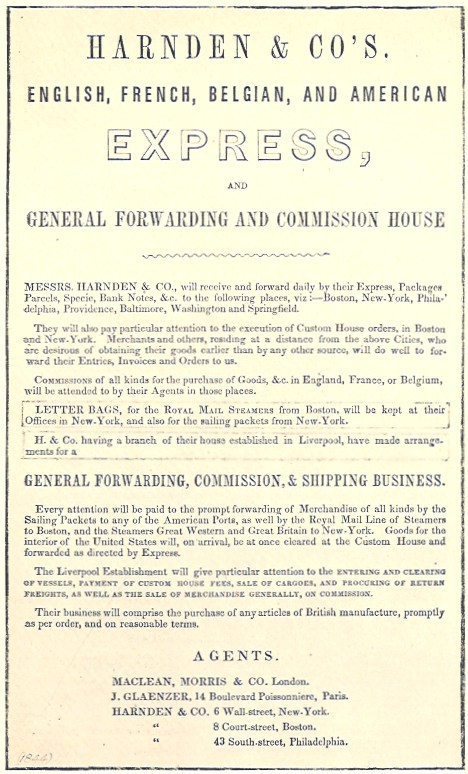
1844 advertisement
Prior to 1848, prepaid mails to foreign destinations was possible only by using agents such as Harnden. For example, a letter prepaid to Harnden in Boston could be sent by steamer to the Liverpool office and mailed by the Harnden agent there, using the British postal system, to any destination linked from England.
I. First Period - Harnden as a contract mail agent (July 1, 1839 to June 30, 1841) Harnden received a contract as a post office mail carrier on July 1, 1839. This contract allowed Harnden to legally carry mails, in locked bags, between Boston and New York City. He carried mail made up in packets, addressed to himself, upon which he paid postage by total weight. The contract expired on June 30, 1841.


A typical cover from this period, dated from New York City and destined abroad for transmission by the Cunard Line, was taken to the New York Harnden office, stamped with the red oval shown above left, and put in a packet with other letters, addressed to Harnden in Boston. It was then taken by Harnden, as a US contract mail agent, in a locked bag to the Boston post office. There, Harnden opened the packet, paid the Boston post master the amount of packet postage due, and the letters delivered to the purser of the Cunard ship for transmission onward. See also collection pages one and two.
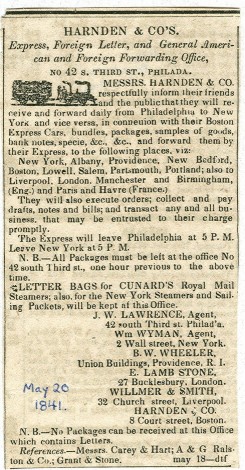
1841 advertisement from Philadelphia newspaper
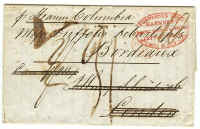 |
First
Period, February 27, 1841 folded letter from New York City to
Bordeaux, France, via a London forwarder, red Harnden's Letter Office,
New York oval handstamp, carried on Cunard Line steamer Columbia
departing Boston on March 2, the first return voyage of this
ship,
manuscript 1/- due, London arrival backstamp, manuscript forwarder
notation of J.H. Schroder on verso and posted to
Paris, 31 decimes due, arrival backstamp,
|
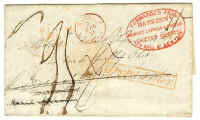 |
First
Period, March 3, 1841 folded letter from New York City to a sailor
onboard the US Ship Ohio, Mediterranean Sea, to the care of Fitch
in Marseilles, red Harnden's Letter Office, New York oval handstamp,
carried on Cunard Line steamer Britannia departing Boston on
March 16, boxed "Packet Letter" handstamp, "America
L" backstamp, London transit backstamp, French entry, and
Marseilles arrival backstamp, manuscript 35 decimes due, very fine
|
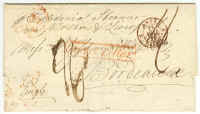 |
First
Period, April 1, 1841 folded outer address leaf from New York City
to Bordeaux, France, red Harnden's Letter Office, New York oval handstamp on verso, carried on Cunard Line
steamer Caledonia departing Boston on April 2, boxed "Packet
Letter" handstamp, "America L" backstamp, London transit
backstamp, French entry, and Bordeaux arrival backstamp, manuscript 26
decimes due, very fine
|
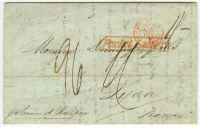 |
First
Period, May 15, 1841 folded letter from New York City
to Lyon, France, additional text of New York forwarded Cottenet dated
May 29/31 and with his backstamp, red Harnden's Letter Office, New York oval handstamp on
verso, carried on Cunard Line
steamer Caledonia departing Boston on June 1, boxed "Packet
Letter" handstamp, "America L" backstamp, London transit
backstamp, French entry, and Bordeaux arrival backstamp, manuscript 26
decimes due, very fine
|
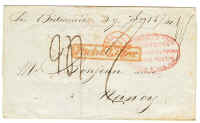 |
First
Period, September 1841 folded outer address leaf from New York City
to Nancy, France, red Harnden's Letter Office, New York oval handstamp, carried on Cunard Line steamer Britannia
departing Boston on September 16, red boxed "Packet Letter"
handstamp, London transit backstamp, French entry, and Nancy arrival
backstamp, manuscript "24" decimes due, very fine
|
II. Second Period - Harnden as a private mail express (July 1, 1841 to February 21, 1842) Without a mail contract, Harnden continued his foreign letter office business in a somewhat modified fashion.
A typical cover from this period bears no evidence of the exact handling except that they bear Harnden's handstamps. It is not clear if he continued to use the government mails for carriage between New York and Boston but I suspect that letters were carried by his messengers outside the mails, thereby depriving the government of revenue. See also collection pages three, four, and five.
III. Third Period - Harnden as a regulated contract mail agent (February 22, 1842 to January 31, 1844) The Post Office renewed the Harnden contract effective from February 22, 1842. It appears that this time, however, Harnden was forced to pay postage on letters handled on an individual basis rather than getting benefit of slightly lower bulk packet postage. The contract also allowed him to carry mail between additional cities, including Philadelphia. This contract expired on January 31, 1844.
Covers from the third period bears post office markings. A typical cover from this period, dated from New York City and destined abroad for transmission by the Cunard Line, was taken to the New York Harnden office, stamped with their marking and taken to the post office to be postmarked. After they were postmarked, they were put into a locked bag and carried by Harnden, as a US contract mail agent, to the Boston post office. There, Harnden opened the packet, paid the Boston post master any postage due, and the letters delivered to the purser of the Cunard ship for transmission onward. See also collection pages six, seven, eight and nine.
IV. Fourth Period - Harnden as a private mail express (February 1, 1844 to 1851) Without a mail contract, Harnden continued his foreign letter office business in a once again modified fashion. He still delivered mails to the Cunard steamers leaving both Boston and New York. The foreign mail offices were closed in 1851.
Covers from the fourth period no longer bears post office markings. It is not clear how he handled mails between his offices. I suspect that letters were made up into parcels and carried by mail on at least some of the routes. Possibly messengers were used on other routes before July 1, 1845 when the government clamped down on the Independent Mail companies. See also collection pages ten, eleven, twelve, thirteen, fourteen, fifteen, and sixteen.
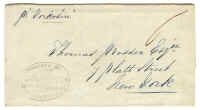 |
Fourth
Period Inbound, October 31, 1844 folded letter from Liverpool to New
York, ship illustrated handstamp of the Liverpool office and endorsed to
be carried per sailing ship Yorkshire, manuscript 6 cents port of
entry ship rate due in New York, fine
|
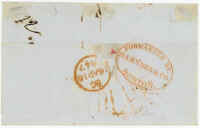 |
Fourth
Period, March 30, 1847 folded outer address leaf from New York City
to Paris, France, red Forwarded By Harnden & Co. Boston oval handstamp, carried on Cunard Line steamer
Hibernia
departing Boston on April 1, red boxed 'colonies 7 Art 13"
handstamp, London transit and French entry datestamps, manuscript 15
decimes due, front here, very fine
|
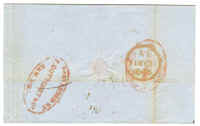 |
Fourth
Period, May 16, 1848 folded outer address leaf docketed as being from
Cottenet in New York City, with his forwarding backstamp, to Huth in
London, England, red Forwarded By Harnden & Co. Boston oval handstamp, carried on Cunard Line steamer Britannia
departing Boston on May 17, manuscript 1/- due, London arrival
backstamp, front here, file folds, fine
|
Richard Frajola (January, 2005)



